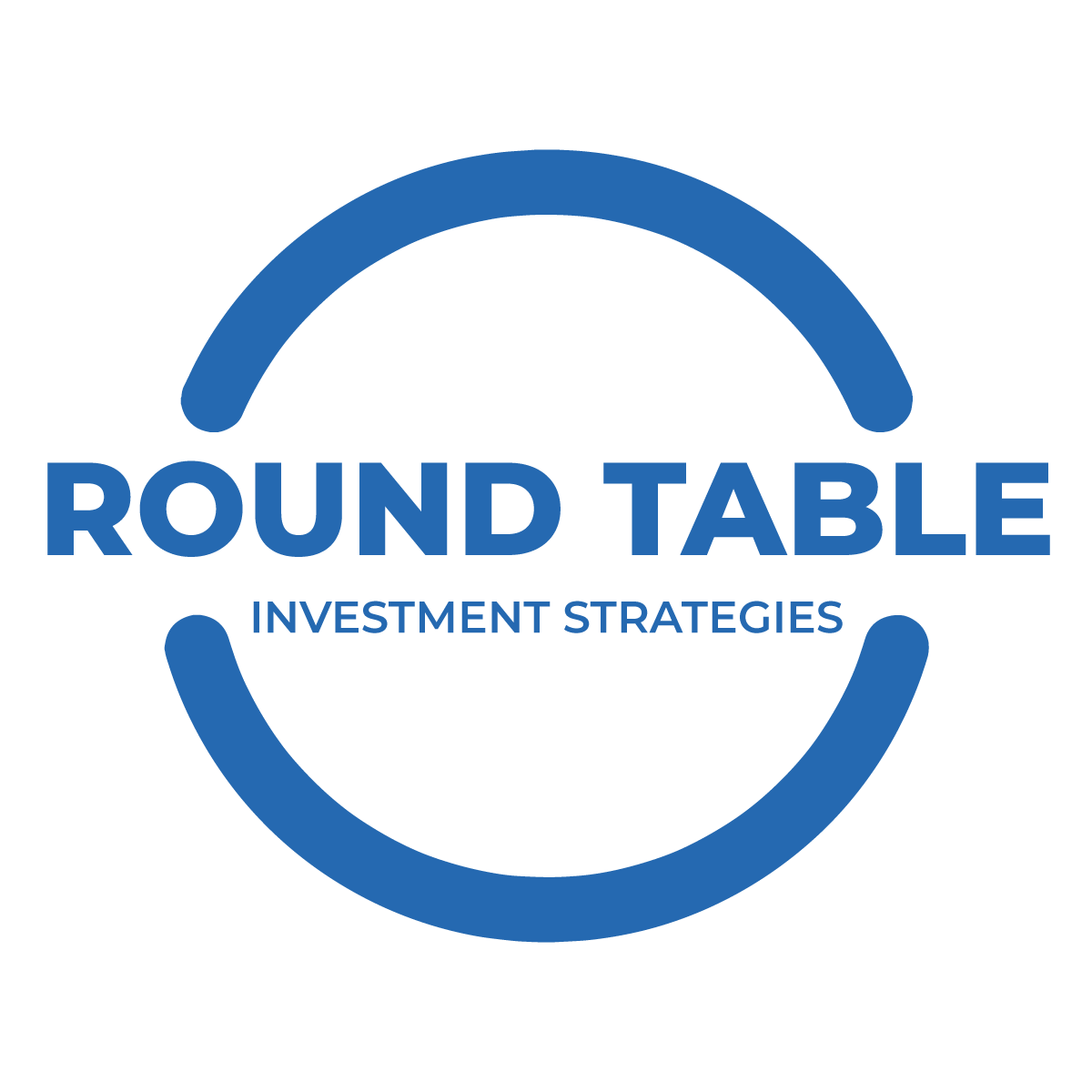Author’s note: Reading this article is like peeling an onion, as we first quantify the recent difficulties for bond investments, then dig deeper into underlying causes. Thankfully, there’s a golden nugget (um…sweet Vidalia?) at the core, and readers are welcome to skip straight there if desired.
Bond Blues
Over the past few decades, down periods for stocks have often involved a pattern of “risk-off” trading that sent capital into bonds instead. This “flight to quality” effect caused bonds to appreciate when stocks suffered significant losses.
Unfortunately, 2022 has been a brutal reminder of the historical reality that stocks and bonds can go down at the same time. How brutal? How about “worst on record” brutal:
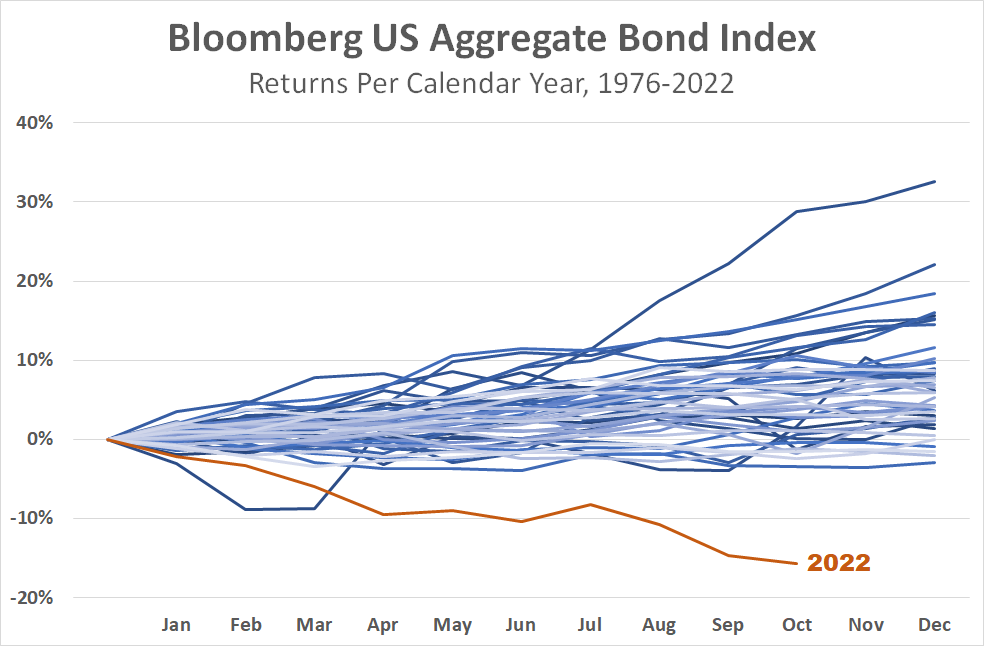
Admittedly the “record” in question, for the US benchmark Bloomberg US Aggregate Bond Index, only goes back to 1976, but a 15.7% drop through October is easily the lowest intra-year return in that timeframe, and more than five times as bad as the worst calendar year experienced previously. Consequently, in a traditional stock/bond portfolio, the bond portion is contributing meaningfully to overall losses this year.
Moreover, whereas the bear market for stocks began in January, the drawdown for the bond index started all the way back in August of 2020, albeit at a very leisurely initial pace, such that the overall drawdown in bonds is now -17.2%. An important point, however: This is the worst drawdown the benchmark Bloomberg Agg has ever seen, and yet it is still well shy of the 20% decline that traditionally demarcates a “bear market”—hence the question mark in this article’s title. This means even the worst performance ever experienced for bonds has still blunted the magnitude of stock/bond portfolio losses in what has been a run-of-the-mill bear market for stocks.[1]
Nonetheless, the fact remains that the magnitude of this drawdown in bond investments is virtually unprecedented. To understand what happened and what it might mean going forward, we will start with the fundamentals of how bonds work.
Bond Basics
Bonds are complicated beasts. You could scare a CFA candidate silly by dressing up as “bond math” for Halloween. Over-the-counter trading and subtle differences between an endless array of issuances make bonds less liquid and less transparent than stocks or even many derivatives.
At their core, bonds are simply a contractual promise to pay a prespecified amount of money in the future.
And yet, at their core, bonds are simply a contractual promise to pay a prespecified amount of money in the future. And interest rates on bonds are nothing more than the rate of return demanded by the market when it sets the price it is willing to pay today to purchase that contractually promised amount in the future.
The simplest type of bond promises to pay a single amount (called the “face value”) on a single date in the future (called the “maturity date”). More commonly, bonds can also promise to make little payments (called “coupons”) every so often—e.g., every 3, 6, or 12 months—between now and the maturity date. Perhaps because they are less common, the simpler, single-payment bonds are named for the complexity they lack: i.e., they are called “zero-coupon bonds” or “zeros” for short.[2]
One way to think of a “normal” bond (called a “coupon bond”) is that it is a combination of one big zero-coupon bond (the face value at maturity) and lots of little zeros (the coupons between issuance and maturity). Unsurprisingly, this makes the bond math on coupon bonds significantly more complex. For this reason, we will use zero-coupon bonds in all examples below.[3]
Interest Rates vs. Bond Prices
Whereas stock values are always quoted as prices, bond values are more commonly quoted as interest rates. As noted above, bond prices and bond interest rates are two sides of the same coin. Specifically, the higher a bond’s price, the lower its interest rate, and vice versa. If you hear, for example, that interest rates went up, you can think to yourself, “That means bonds lost value.”
Here is a simple illustration on a bond with one year to maturity and a $100 face value:
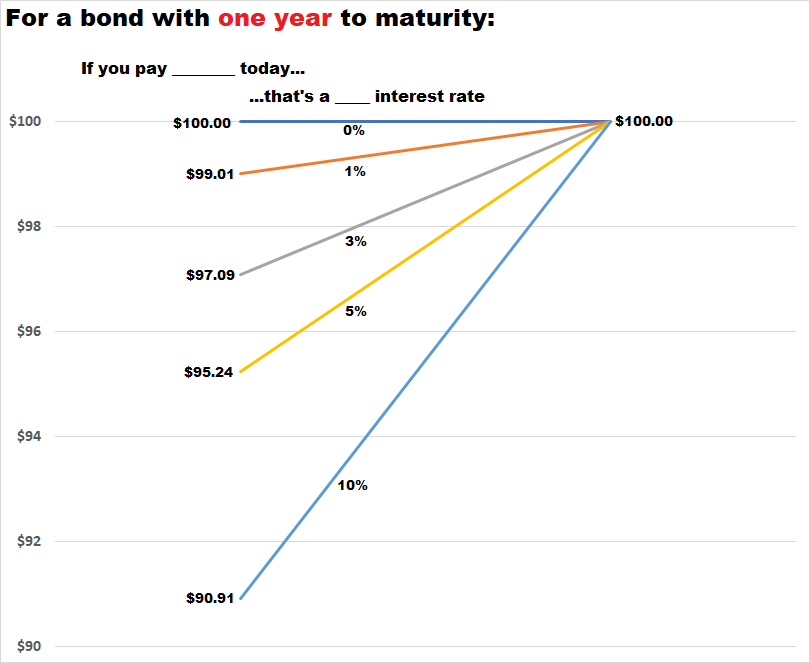
As you can see, the lower the price investors pay today, the higher the interest rate they capture, since the bond matures at $100 regardless. If, for example, someone pays $95.24 for this theoretical one-year zero-coupon bond, they will make $4.76 in profit in one year, since the bond will mature at its $100.00 face value. The interest rate is $4.76/$95.24 = 5%. But if they pay $99.01, they will only make 99 cents, capturing a mere 1% interest rate.
Implications in a Rising Rate Environment
Unfortunately, this also means that if interest rates rise after investors purchase their bonds, the value of the bonds they own will fall.
In the illustration above, that isn’t such a big deal, for two reasons. First, even a jump from 0% to 10% interest rates incurs less than a 10% loss ([$100.00 – $90.91]/$100.00 = 9.1%). Second, if the bond is held for just one year, those losses are fully recovered.
This becomes more problematic when a bond has a longer maturity, i.e., when the final payout is further in the future. Interest rates are always stated as annualized figures. If a bond has a maturity of N years and an interest rate of X%, that means it will earn X% per year for N years, not X% just once over N years. Consequently, the price today for a bond with a longer maturity must be lower than the price for a bond with a shorter maturity if the two bonds have the same interest rate. Here’s an illustration with a 10-year zero-coupon bond:
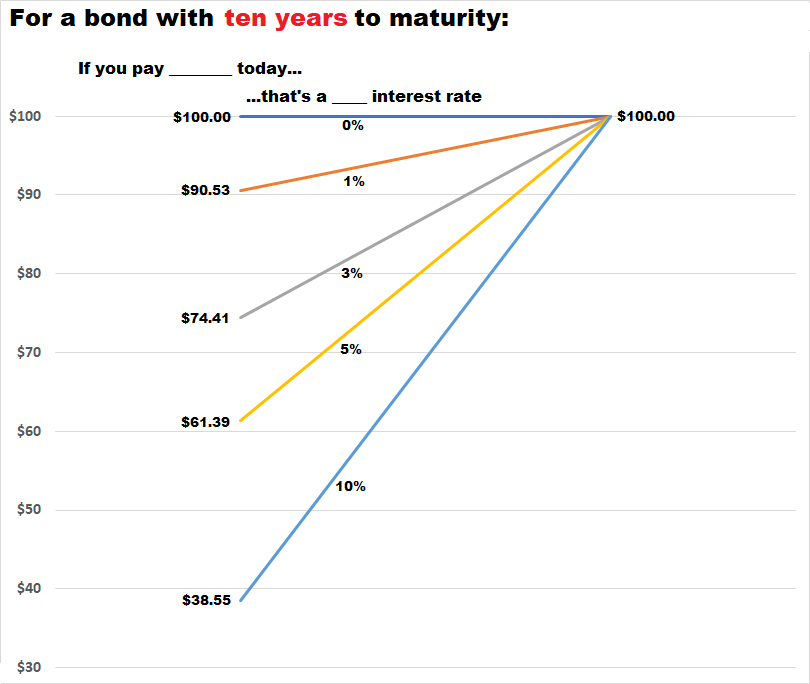
A sudden jump in interest rates from 0% to 10% would cause a 9.1% drop in value for a one-year bond, but it would cause a 61.5% drop in value for a ten-year bond. As bad as this year has been for bonds, thank goodness we haven’t seen a 10% spike in interest rates!
We have, however, seen interest rates jump from about 0% for the shortest maturity (i.e., less than one year) Treasury bonds and about 2% for the longest maturity (up to 30 years) Treasurys,[4] up to more than 4% for nearly all maturities, in less than a year.
Here’s a back-of-the-envelope calculation for what this has meant:
- The effective duration of the U.S. benchmark Bloomberg Aggregate Bond Index—“duration” being a number that for this exercise you can sorta-kinda think of as the average number of years to maturity across all bonds in the index[5]—is a little over 6 years.
- From the beginning of January through the end of October, six-year interest rates rose from about 1.4% to about 4.1%. (Per interpolation between the five- and seven-year rates from the Treasury’s data page here.)
- A jump in rates on a six-year bond from 1.4% to 4.1% implies a drop in value of about 14.6%—not too bad as a back-of-the-envelope estimate for the 15.7% drop experienced by the Index over that period.[6]
But Why Have Interest Rates Risen?
I can think of two sensible responses to this question:
- Option 1: Market movements do not come with secret agent decoder rings, and any attempt to explain the complexities of interest rate variations with straightforward stories risks oversimplification at best and misrepresentation at worst.
- Option 2: It was inflation, of course.
As to why inflation can lead to higher interest rates, we previously provided plausible and noncontradictory market-driven and Fed-driven explanations in this footnote and this footnote, respectively.
But please don’t ignore Option 1, even if we[7] just did. Thinking we[8] know why the market has moved can be like a gateway drug to thinking we know where it will move next. (And the fact that even inflation-protected bonds have seen a large spike in interest rates this year should at least give some pause.)
Also Credit Spreads
The duration-based example above used interest rates on US government-issued Treasury bonds, which are generally considered to be “risk-free” investments, in the sense that there is virtually no risk that the government will fail to repay. However, many of the bonds in the bond index are either corporate or mortgage-backed issues that have some small repayment risk.[9] In exchange for taking on that risk, the market charges a “credit spread” in the form of higher interest rates on those bonds vs. Treasury bonds of the same maturity.
Just as the “risk-free” interest rates for Treasurys of various maturities change over time, so too do the magnitudes of these credit spreads for non-Treasury bonds. In general, the “scarier” the economic backdrop, the “wider” (i.e., larger) the spread.
Given the apparent migration from growth, unicorns, and joy last year to inflation, stagnation, and bogeymen this year,[10] it’s small wonder that credit spreads have also widened in 2022, causing interest rates on non-Treasury bonds to jump even more than interest rates on Treasurys. This increase in credit spreads is likely the primary contributor to the underestimate in the back-of-the-envelope example above.
On the Plus Side!
There is good news in all of this! Yes, bond prices have fallen sharply because interest rates have risen substantially. But then again, interest rates have risen substantially as bond prices have fallen! Insofar as interest rates are a good proxy for expected future bond returns, this means expected future returns for bonds are much higher now than they were at the end of last year! Indeed, while such judgments are necessarily subjective, one could argue that bond yields look rather attractive for the first time in well over a decade.
“So what?” say certain clever readers, “If I’m going to wind up with the same payment at maturity anyway, then what good does it do me to lose money this year just to make it up over time and wind up in the same place?” If bond investing were nothing but a one-time game, this question would be well-taken.[11] If prices drop on day one and then stay at the newer, higher level, then the amount of time to recoup those day one losses will indeed be essentially equal[12] to the duration of the portfolio.
However, most bond investors likely have an investing horizon that is longer than the duration of their bond portfolios. Consequently, investors typically engage in a strategy of “rolling” their bond positions forward, buying new bonds and either selling old bonds or allowing them to mature. Often, they will purchase funds (e.g., mutual funds or ETFs) that execute this strategy for them. So yes, the jump in interest rates—if it lasts—may mean it will take a while for investors to recover this year’s bond losses; but once the losses have been recovered, higher interest rates—again, if they last[13]—would continue to provide higher returns than would have been achieved otherwise, and there’s good reason to believe bond investors can come out ahead in the long run.[14]
The following chart from Dimensional Fund Advisors illustrates this concept using a five-year-duration bond portfolio as an example:
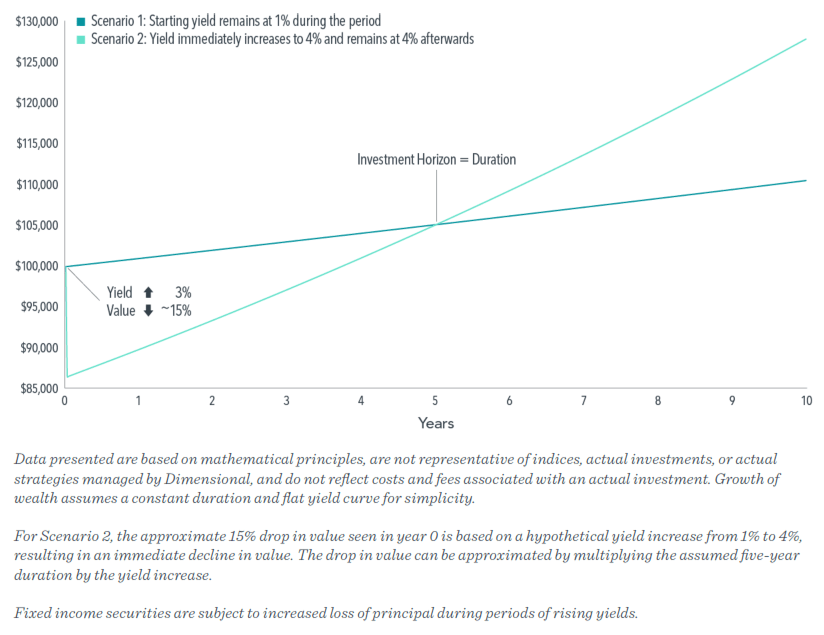
As a bonus, that interest rates are now higher also implies higher interest accruals, which will help blunt the losses even if interest rates continue to rise from here.[15]
What Does This Mean for You Specifically?
Simply put, we can’t answer that question here. But we’d be happy to develop an answer to that question as part of a full-fledged financial and investment plan: Contact Round Table to get started!
[1] Lest I call down a nasty jinx upon the world’s investors, I will add here, “at least so far,” in the hope that explicit utterance will render such circumspect qualification unnecessary in the end.
[2] Which makes them sound like loser bonds, or maybe Japanese fighter planes.
[3] Also annual compounding. Nothing about bond math is simple, but this is as simple as we can make it.
[4] See this footnote from a prior article regarding the spelling of “Treasurys.”
[5] Especially if you stick with the creative fiction that a coupon bond has one big maturity (face value) and lots of little maturities (coupons). More especially if you use Macaulay duration instead of Modified duration. Bond math, oy…
[6] Actually, I’m cheating a bit, since I’m ignoring the fact that most of a year’s worth of interest has been accrued as well, so the magnitude of the drop estimated here undershoots reality by more than it appears. See the section below on credit spreads for an additional culprit.
[7] We still find ourselves employing the “royal we.” Sometimes we just think it sounds better to us.
[8] Not the royal we. This warning is for anyone.
[9] Mortgages also have something called “prepayment risk,” which, among other things, affects something called “convexity,” which is the rate of change of duration with respect to changes in interest rates. It is also important. And that’s all we have to say about it. (Also, Investopedia should be paying us royalties for all the links we’ve given them in this article.)
[10] Perhaps not the most technically precise description of recent economic developments, but still…
[11] Notably, this one-time-game approach to bond investing has real applications. One example near and dear to our hearts at Round Table is the use of bond laddering with Treasury Inflation-Protected Securities (TIPS) to purchase an inflation-adjusted stream of income. But in that example, the fact that you wind up in the same place no matter what is the whole point!
[12] Or exactly equal, depending on how simplistically you craft your example.
[13] If they don’t last, then the more attractive expected returns will shrivel, but at least investors will make some of this year’s losses back more quickly, since that’s what lower interest rates imply.
[14] A real return aficionado like myself must hasten to add—if only in a footnote—that this seems likely to be true not just in nominal dollar terms but in inflation-adjusted terms as well, as real interest rates have risen almost as much as nominal interest rates in 2022, even though the jump in nominal rates was largely driven by higher-than-expected inflation.
[15] That convexity thing might help a bit too, assuming positive average convexity in a typical bond portfolio. (Oops, I said I wasn’t going to mention that again.)
DISCLOSURES: All content is provided solely for informational purposes and should not be considered an offer, or a solicitation of an offer, to buy or sell any particular security, product, or service. Round Table Investment Strategies (Round Table) does not offer specific investment recommendations in this presentation. This article should not be considered a comprehensive review or analysis of the topics discussed in the article. Investing involves risks, including possible loss of principal. Despite efforts to be accurate and current, this article may contain out-of-date information, Round Table will not be under an obligation to advise of any subsequent changes related to the topics discussed in this article. Round Table is not an attorney or accountant and does not provide legal, tax or accounting advice. This article is impersonal and does not take into account individual circumstances. Reading this article does not create a client relationship with Round Table. An individual should not make personal financial or investment decisions based solely upon this article. This article is not a substitute for or the same as a consultation with an investment adviser in a one-on-one context whereby all the facts of the individual’s situation can be considered in their entirety and the investment adviser can provide individualized investment advice or a customized financial plan.
The data shown in this article is for informational purposes only and should not be considered as an investment recommendation or strategy, or as an offer to buy or sell any particular security, product, or service. Past performance may not be indicative of future results. While the sources of data included in any charts/graphs/calculations are believed to be reliable, Round Table cannot guarantee their accuracy.
